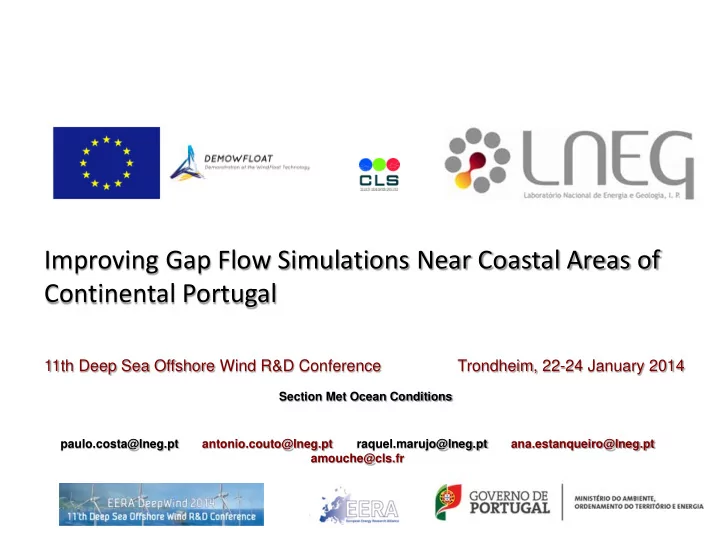

Improving Gap Flow Simulations Near Coastal Areas of Continental Portugal 11th Deep Sea Offshore Wind R&D Conference Trondheim, 22-24 January 2014 Section Met Ocean Conditions paulo.costa@lneg.pt antonio.couto@lneg.pt raquel.marujo@lneg.pt ana.estanqueiro@lneg.pt amouche@cls.fr
Gap Flows • Gap flows are locally generated wind currents that spread abruptly to the ocean, triggered by non-linear atmospheric phenomena. • Its intensity and spreading may bring several impacts near coastal areas in particularly where offshore wind parks can be deployed.
Gap Flows Modelling this phenomena is still • a challenge from the meteorological point of view since models still not reproduce efficiently way gap flows, especially, the ones occurring very near the coasts. • A high resolution satellite SAR image is nowadays the “ best observational spatial wind tool ” to detect the phenomena in action
Gap Flows in Portugal • At 9th December 2010 strong gap flows were identified along some western coastal Berlenga regions of Continental Island Portugal • This region contains several promising sea areas with high sustainable wind resource for offshore wind park’s deployment
Gap Flows in Portugal The phenomena in action… This “zoomed” SAR image on day, 9th December 2010 @ ~ 22:30h shows the gap flows (surface). “red zones” wind speeds ~ 20 to 30m/s “green zones” – vicinity ~ 10 to 13 m/s “blue zones” -around ~ 3 to 6 m/s
Gap Flows in Portugal LNEG operates three anemometric masts in the region. At that day & time, observed mean wind speed and direction was: IN01 ( sensor height 10m ): ~ 9.86 m/s ; ~ 90º IN33 ( sensor height 10m ): ~ 8.76 m/s ; 65º IN166 ( sensor height 21m ): ~ ? m/s ; ?º ( data with -9999 error code )
Gap Flow Simulation Simulation tasks: To set up a high resolution mesoscale • simulation with the WRF model for the case study day (09.12.2010); To use the 3D-VAR data assimilation • technique; • To compare model’s results with and without data assimilation and to validate the simulated wind flow with LNEG’s anemometric masts
Assimilation advantages • Assimilation of observations will reduce error forecasts • Reducing error forecasts means getting better forecasts!
3D-VAR assimilation A “BLUE” method ... “Best Linear Unbiased Estimate” ≅ Kalman Filter Gain Inovation Backgroud error Mean forecasts @12h - @00h covariance matrix
Gap Flow Simulation Setup WRF model … As a background “run” D03 @ 2x2km • Three domains covering the area under study; 50x50km ; 10x10km and 2x2km; • Historical initial and boundary conditions from GFS forecast model @ 0.5x0.5º, ingested every three hours; • Running period: 1 day - 1200h 09-12-2010 to 1200h 10-12-2010
Gap Flow Simulation Setup WRF model … Assimilation “run” - 3D-VAR • Assimilated “SAR” wind data image at 21h (09-12-2010) @ all model domains; • Assimilated surface synoptic data at 12h, 18h and 21h from x LPPT Lisbon station (T,Hr,P,U,V) • Assimilated IN01 & IN33 at 12h, 18h and 21h ; • Validation: IN01 & IN33 (daily period)
WRF forecasted results (2x2km) – (surface) @ 2200h 09-12-2010 m/s Control run SAR No data assimilation. . % Assimilation improvement Assimilation run . .
WRF forecasted results (2x2km) – (surface) from 1200h 09-12-2010 to 1200h 10-12-2010 Wind speed comparison (m/s) @ IN01 (h=10m) FORCED: 3D-VAR @ 12h & 18h Gap Flow event IN01 + IN33 + synoptic LPPT Assim. run Obs IN01 FORCED: 3D-VAR @ 21h SAR + IN01 + IN33 + synoptic LPPT Mean wind speed (m/s) wind speed (m/s) @ 22h Correl –NA (%) Correl – A (%) WRF-NA WRF-A Obs WRF-NA WRF-A Obs 77.22 83.19 8.18 8.21 9.60 8.29 7.98 7.83
Results Observational assimilated data • slightly improved WRF forecasted estimates in IN01 place - very near to the coast. • SAR image helped in the description of the phenomena - with positive (30%) and negative (-35%) impacts when compared with “background run”. The origins of the phenomena are being studied and further simulations are being conducted in order to improve its performance. • Other similar coastal phenomena cases will be investigated and, if possible, on other countries’ offshore wind deployment areas.
This work was partially sponsored by the European Union FP7 under project DEMOWFLOAT Thank you! Improving Gap Flow Simulations Near Coastal Areas of Continental Portugal Paulo Costa 11th Deep Sea Offshore Wind R&D Conference paulo.costa@lneg.pt Trondheim, 22-24 January 2014 Ana Estanqueiro Section Met Ocean Conditions ana.estanqueiro@lneg.pt
Recommend
More recommend